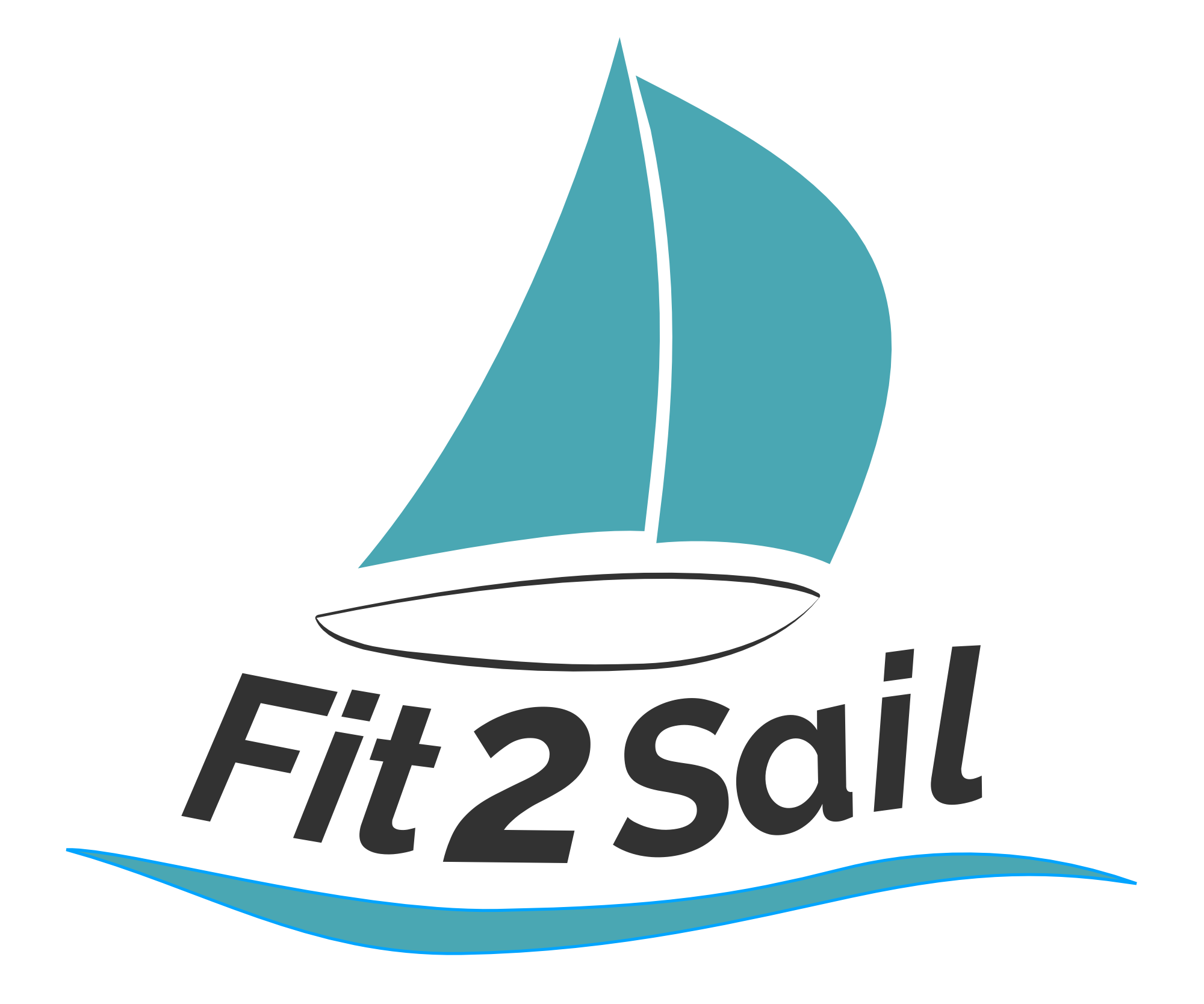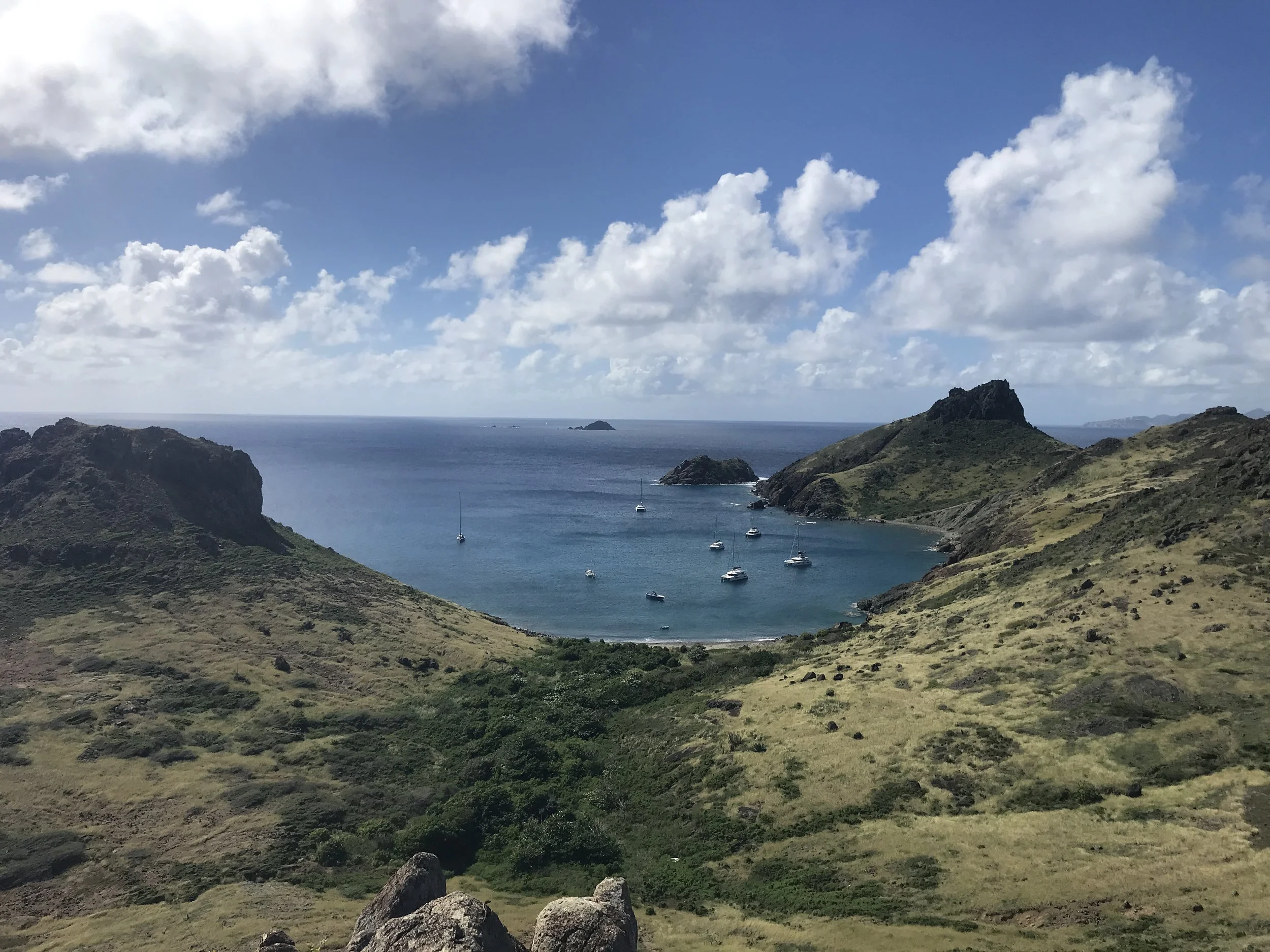Six Days in St. Barths
We’ve got some lovely history in St Barths, rooted in time there with our friends David and Alison when they lived on the island for a couple of years after college. A week’s stay with our boat buddies on Mahalo during our first cruise cemented the feeling - and we weren’t about to miss out this time around.
View of Gustavia harbor, from the lighthouse. Find Calypso!
St Barths (officially Saint Barthelemy; sometimes written as St Barts) has a reputation for being a pretty exclusive playground of the rich and famous. For those too poor to afford their own private island, this is apparently the next best thing. Stores on the well-tended streets proudly proclaim “St Tropez et St Barths”; one spot we ducked in offered t-shirts (yes, just regular cotton t-shirts) at $85. The Le Select bar, just off the waterfront in capital Gustavia, is supposedly where Jimmy Buffett got the inspiration for his Cheeseburger in Paradise. (Minor quibble - the burgers did NOT come with a kosher pickle, big OR small!)
Note the tagline.
All of the above, plus a confusing and unclear fee structure for time spent cruising the island, has turned a few people off. Friends of ours, when we told them of our plans, told us to watch out for the costs. Consider us warned - not, though, warned off. If you’re in the area, don’t be warned off either! (Our total costs, for 2 days anchored just outside of Gustavia harbor and 4 days in the park, came to 39 Euros.)
Freshly stocked up from the stores in St Martin, we sailed the 20 miles or so to St Barths one lovely Thursday afternoon. A small pod of small dolphins leaped out of the water in their haste to get to play in our bow wave; they played for a few minutes before heading off. Our first dolphins in the Caribbean!
Colombier is in the northwest corner; the whole island is only 11 miles wide.
Gustavia and the anchorages around that capital were BUSY, filled with moorings and local boats. Cruising boats rolled in the swell and wake. Even the mega yachts outside the harbor were moving around. Time to head to Colombier, a little bay on the northwest side with a steep beach that has no road access - reaching that stretch of sand requires either a boat or a mile walk. This bay wasn’t immune to the roll that plagued Gustavia, but we could take the dinghy for a ride along the cliffs back to town, and the roll looked worse than it felt on board. Jeremy did the cliff walk to recreate a favorite photo from our time with Mahalo while I lounged in the cockpit being entertained by the mega yacht crews setting up elaborate beach oases for their guests. It took one guy three tender trips of gear to set up an especially fancy one, complete with shade, chairs, corn hole, volleyball, tables with food and coolers, speakers and music. Oh, and 3 underwater sled things anchored just off the beach. We figure that this must be a specific role on board - the beach person. Taking it down at the end of the day took even longer. And no, the captain who was driving the yacht’s tender didn’t lift a finger to help.
After 2 nights there, we picked up the hook to sail over to Ile Fourche, an uninhabited island that lies maybe 2 miles offshore, towards St Martin. There’s a deep bay with a few free moorings. No beach, but great hiking on the island. Don’t be put off by the large red “PRIVATE PROPERTY” sign (or the spray painted rock that says “No trespassing” right at the first part of one trail) as closer reading reveals that you’re just asked to respect the property. There are 5 peaks, as it were. Jeremy hiked 3 of the 5, coming back to report that the scramble up the rocks would not have been my favorite (I have a bum knee that doesn’t like uneven ground). Together we did one shorter hike. It’s amazing how getting even a few hundred feet above sea level can provide some truly excellent views! The trails are largely the result of now-absent goats and crisscross over a large swath of the island. On board, the entertainment bounced between watching the crew on the monster sailboat behind us put away the main (by walking on it in the boom), watching the sea turtles pop their heads up and submerge again, and gasping at the wind gusts that picked up spray as they traveled along the water. Less rolly than Colombier, the anchorage suffered more from those wind gusts. Maybe it was the different peaks, but the williwaws came from all directions and triggered our 28 knot wind alarm multiple times during the night. Not much sleep was happening on Calypso.
See Calypso in the anchorage?
It looked like we had a weather window shaping up to sail to Antigua, the last major eastbound hurdle on the main route to Trinidad, so back to Gustavia we went. Alison’s goddaughter lives on the island, so we wanted to catch up with her. Plus we had to check out and do a little more exploring. Getting the wind angle to be able to SAIL to Antigua (instead of just motoring) was a big big plus. We didn’t want to pass it up.
This time we chose to anchor just outside of Gustavia, on the east side. Still rolly, but easier access to town. A bit less busy, a bit more private. At least until a charter boat decided to anchor almost on top of us . . . Sigh.
Time in town was lovely. We set up a late afternoon meeting time with Elodie and picked up a baguette at the grocery store to tide us over until the next day’s boulangerie run. And the next day we loaded up with fresh baguettes and croissants, walked up to the lighthouse for a late breakfast, and then kept on walking over the island to St Jean, stopping on the way to gasp and flinch as the planes flew what seemed like inches over our heads on their way to the short runway that lies at the base of a steep hill and ends at the water. Those pilots have nerves of steel. A quick visit to the grocery store to get a few goodies, walk back over the hill to the boat, and prep for the 75 mile sail to Antigua.
The planes zoom right overhead, down the hill to the runway, to the bay.
Prepping for offshore largely entails dealing with the dinghy. Off comes the outboard (it’s stored on a bracket fixed to the port side boom gallows). This involves a lifting jig attached to the boom, which we raise high. I push the boom out to stabilize it while Jeremy is in the dinghy undoing the outboard. There’s some tricky maneuvering (especially in the roll!) to make sure the heavy outboard doesn’t smash into the solar panels, but between the 2 of us we make it work. The new 9.8 hp motor is MUCH lighter than the old 15, which is helpful. It’s still awkward.
The new dinghy is an inflatable one, which means we bring it aboard and deflate it completely, rolling it up into a fairly tidy package. Back in Maryland, one of the last major projects was to install 4 tie-down points for the dinghy. These are folding padeyes, bolted through the cabin top. We criss-cross webbing straps across the dinghy package for very secure storage.
Of course, there are other items to tick off the departure list. Stow items below. Gimbal the stove. Set up the jacklines. Dig out the harnesses. Secure the anchor once it’s raised. Dig out the gaff, gloves, and vodka in case we get a fish. Oh. That last? We just added to the list. Story coming soon!





